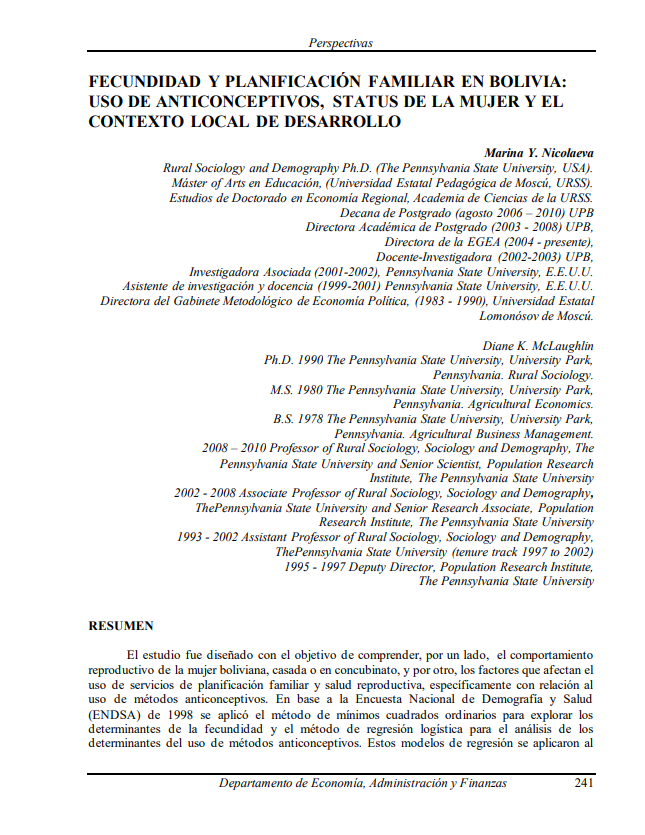Fertility and family planning in Bolivia: contraceptive use, women’s status, and the local development context
DOI:
https://doi.org/10.35319/amcshj45Keywords:
Reproductive behavior, Reproductive health, Family planning, Contraceptive methods, Sociodemographic segmentationAbstract
The study was designed with the aim of understanding, on one hand, the reproductive behavior of Bolivian women who are married or in cohabitation, and on the other, the factors that affect the use of family planning and reproductive health services, specifically regarding the use of contraceptive methods. Based on the 1998 National Demographic and Health Survey (ENDSA), the ordinary least squares method was used to explore the determinants of fertility, and the logistic regression method was used to analyze the determinants of contraceptive use. These regression models were applied to the total population of Bolivian women and to differentiated segments based on the language they speak (indigenous or non-indigenous) and the area in which they live (rural or urban). The results show that the effects of: i) the woman’s demographic characteristics, ii) her partner’s characteristics, iii) community characteristics, and iv) beliefs, as well as couple interaction regarding family planning services, vary according to area of residence and the language spoken by the woman. These results suggest that the differentiation of these segments should be considered when designing reproductive health and family planning policies.
Downloads
References
Agadjanian, V. y Nicolaeva, M. (2002). “Ethnicity, fertility and contraception in Bolivia.” Poster, Annual Meeting of the Population Association of America. Atlanta, GA.
Bongaarts, John (1978). “A framework for analysing the proximate determinants of fertility.” Population and Development Review, 4: 105-132.
Bongaarts, John; Mauldin, W. Parker; y Phillips, James F. (1990). “The demographic impact of family planning programs.” Studies in Family Planning, 21: 299-310.
Casterline, John B. y Sinding, Steven W. (2000). “Unmet need for family planning in developing countries and implications for population policy.” Population and Development Review, 26(4): 691-723.
Davis, K. y Blake, J. (1956). “Social structure and fertility: an analytic framework.” Economic Development and Cultural Change, 4: 211-235.
Demeny, Paul (1986). “Pronatalist policies in low-fertility countries: patterns, performance, and prospects.” Population and Development Review, 12: 335-358.
Easterlin, R.A. y Crimmins, E.A. (1985). The fertility revolution – A supply demand analysis. Chicago: University of Chicago Press.
Encuesta Nacional de Demografía y Salud (1998). Instituto Nacional de Estadística y Demographic and Health Surveys, Macro International Inc.
Futures Group International (2000). Health reform, decentralization, and participation in Latin America: protecting sexual and reproductive health. POLICY Project, Washington, D.C. USAID Contract No. CCP-C-00-95-00023-04.
Gertler, Paul J. y Molyneaux, John W. (1994). “How economic development and family planning programs combined to reduce Indonesian fertility.” Social Demography Readings, 31: 33-63.
Nicolaeva, M. y McLaughlin, D. K. (2003). “Barriers to contraceptive use in Bolivia: a preliminary examination.” Disponible en: http://www.pop.psu.edu/general/Barriers_files/frame.htm
Pollak, R.A. y Watkins, S. (1993). “Cultural and economic approaches to fertility.” Population and Development Review, 19: 467-496.
Pritchet, Lance H. (1994). “Desired fertility and the impact of population policies.” Population and Development Review, 20: 1-56.
Terborgh, Anne; Rosen, James E.; Santiso Gálvez, Roberto; Terceros, Willy; Bertrand, Jane T.; y Bull, Sheana E. (1995). “Family planning among indigenous populations in Latin America.” International Family Planning Perspectives, 21(4): 143-149.
Tórrez Pinto, Hugo (1996). “Bolivia: the social and geographic context of trends in fertility.” En: Guzmán, José M.; Singh, Susheela; Rodríguez, Germán; y Pantelides, Edith A. (eds.) The fertility transition in Latin America, pp. 359-372. Clarendon Press: Oxford, Inglaterra.
United Nations (1999). Levels and trends of contraceptive use as assessed in 1998. Nueva York.
Vidal-Zeballos, D. (1994). “Social strata and its influence on the determinants of reproductive behavior in Bolivia.” DHS Working Papers, N° 12. Macro International Inc., Calverton, Maryland, USA.

Downloads
Published
Issue
Section
License
Copyright (c) 2010 Revista Perspectivas

This work is licensed under a Creative Commons Attribution-NonCommercial-ShareAlike 4.0 International License.
La Revista Perspectivas de la Universidad Católica Boliviana, es una revista de acceso abierto, por lo tanto, es de libre acceso en su integridad. Está permitida su lectura, búsqueda, descarga, distribución y reutilización legal en cualquier tipo de soporte únicamente para fines no comerciales, siempre y cuando la obra sea debidamente citada.




